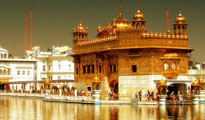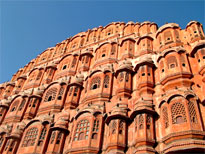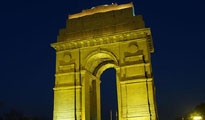Golden Triangle & Ganges Tour
Delhi - Jaipur - Agra - Varanasi - Delhi (08 Nights / 09 Days)
Day 01/Arrival DelhiWelcome to capital of India! Arrive Delhi, meet assist at the airport by our tour executive & transfer to hotel. Overnight at Delhi.
Day 02/Delhi Breakfast in hotel, after breakfast proceed for sightseeing Old Delhi & New Delhi.
OLD DELHI - A sight-seeing tour of Old Delhi would entail visiting:- Red Fort - The red sandstone walls of Lal Qila, the Red Fort, extend for two km and vary in height from 18 metres on the river side to 33 metres on the city side. Shah Jahan started construction of the massive fort in 1638 and it was completed in 1648. Jama Masjid - Jama Masjid The splendid mosque built by Muhammad Ali Shah in the typical Mughal style with two minarets and three domes, lies to the west of the Hussainabad Imambara, Raj Ghat - the memorial site where Mahatma Gandhi was cremated.
NEW DELHI - An extensive sight-seeing tour of New Delhi would include a visit:-
Humayun's Tomb - Built in the mid 16th century by Haji Begum, senior wife of Humayun, the second Mughal emperor, Humayun's Tomb is an early example of Mughal architecture built in Delhi. Qutub Minar - 13 km to the south of Connaught Circus at Lalkote of 8th century Tomor Rajputs, the 72.5 m high Victory Pillar stands as a victory stand of a Muslim King Kutub-ud-din-Aibak in India. A drive along the ceremonial avenue - Rajpath, past the imposing India Gate, Parliament House, the President's Residence, Lotus Temple and would end with a drive through the Diplomatic Enclave. Overnight at Delhi.
Day 03/Delhi - Jaipur ( By Train )
Early morning pick up from hotel & transfer to New Delhi railway station to board the airconditioned Shatabadi express train to Jaipur. Breakfast in the train. Arrive Jaipur and then transfer to hotel. Later proceed for sight seeing tour of Jaipur :- AMBER FORT PALACE - Amber Fort, is one that cannot be easily described. The Amber Fort set in picturesque and rugged hills is a fascinating blend of Mughal Architecture, construct by Raja Mann Singh in 1592 and completed by Swai Jai Singh, the fort is made in red sand stone and white marble. The rugged forbidding exterior belies an inner paradise with a beautiful of art and architecture. Amber Fort is the classic and romantic fort palace with a magnificent aura. The interior wall of palace depicts expressive painting scenes with carvings, precious stones and mirror settings. CITY PALACE - The City Palace is a blend of Mughal and Rajasthani architecture and the royal family still lives in a part of the Palace. The building now forms the Maharaja Swai Man Singh II Museum and on display here are a wide array of royal costumes, some vary exquisite and precious pashmina (kashmiri) shawls, Benaras silk sarries sauganeri prints and folk embroidery. An unusual display is that of voluminous clothes worn by Maharaja Sawai Madho Singh I (Ruled 1750 -1768). JANTAR MANTAR - Jantar Mantar (Observatory) has the Jaiprakash Yantra, Samrat Yantra, Ram Yantra and the Composite instrument, which comprises of a sundial and a massive hemisphere. The Jantar mantar in Jaipur is the most famous one among the five observatories built by Sawai Jai Singh. Overnight at Jaipur.
Day 04/Jaipur- Agra
Breakfast in Hotel, after breakfast visit the majestic HAWA MAHAL - The Hawa Mahal, which adjoins the famous City Palace wall, was built in 1799 by Maharaja Sawai Pratap Singh and has now become one of the major landmarks of Jaipur. The palace is shaped like a pyramid and is a five-storied building, with number of small windows and screens, with arched roofs. Since the Hawa Mahal was built at a time when women of the royal families had to observe strict purdah, many believe that the Hawa Mahal was built, just so these ladies could watch the processions and various activities taking place on the streets. Later drive to Agra enroute visiting Fatehpur Sikri - The Imperial city of the Mughal dynasty. It is very difficult to express the architectural grandeur city as one can only experience the aura of these forts. Famously known as the city of Ghosts, it was built by the great Mughal Emperor. Arrive Agra & transfer to hotel. Evening at leisure. Overnight at Agra.
Day 05/Agra-Varanasi ( By Train )
Breakfast in Hotel, after leisurely breakfast visit the magnificent Taj Mahal – A white marble Tomb building 1631 – 1648 in Agra, seat of the Mughal Empire by Shah Jahan for his wife, Arjuman Banu Begum, the monument sums up many of the formal themes that have played through Islamic architecture. Its refined elegance is a conspicuous contrast both to the Hindu architecture of pre – Islamic India, with its thick walls, corbelled arches and heavy lintels and to the Indo Islamic styles, in which Hindu elements are combined with an electric assortment of motifs from Persian and Turkish sources. Visit the Agra fort – situated on the banks of Yamuna river, north west of the Taj Mahal, this majestic fort was started by the Emperor Akbar and it developed as a strong hold of the Mughal Empire, under successive generations. This majestic fortness of red sandstone encompasses with in its 2.5 km long endosure walls, the imperial city of the Mughal rulers. Later transfer to Agra railway station to board the overnight train to Varanasi.
Day 06/Varanasi
Arrive Varanasi, breakfast in Hotel visit the oldest living city in the world & said to be the India’s most sacred city situated on the western bank of the holy river Ganga. Visit Temples, Durga Temple - Located 2 kilometres south of the old city, this eighteenth century Durga Temple is also known as the Monkey Temple due to many aggressive monkeys that reside here. The temple was built in a common north Indian style with an ornate shikhara, consisting of five segments symbolizing the elements and supported by finely carved columns. Vishwanath Temple - The temple is located in the premises of the Banaras Hindu University and is about thirty minutes walk from the gates of the university. Evening view “Aarti” ceremony on the Ghats. Overnight at Varanasi.
Day 07/Varanasi
Breakfast in Hotel, Morning boat cruise at the river Ganges to observe the way of life of pilgrims by the Ghats. Later excursion to Sarnath, 10kms. Bharat Mata Mandir - This temple of Bharat Mata (Mother India), inaugurated by Mahatma Gandhi, lies about 3 kilometres west of Godaulia, outside the old city. Here, instead of gods and goddesses, one finds a huge relief map in marble of the whole of Indian subcontinent and Tibetan plateau. Tulsi Manas Temple - Built in 1964, the Tulsi Manas Temple stands about 150 m south of Durga Temple. The temple, dedicated to Lord Rama is situated at the place where Tulsidas, the great medieval seer, is believed to have lived and written the great epic ” Shri Ramcharitmanas”. Overnight at Varanasi.
Day 08/Varanasi - Delhi ( By Flight )
Breakfast in Hotel, after a breakfast transfer to airport for flight to Delhi. Arrive Delhi & transfer to hotel. Overnight at Delhi.
Day 09/Departure
Transfer to International airport on time to board flight for onward journey or way back home.












